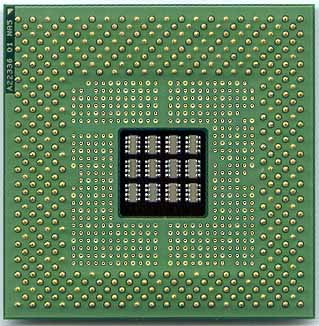Intel Pentium 4 1.4GHz & 1.5GHz
by Anand Lal Shimpi on November 20, 2000 12:54 AM EST- Posted in
- CPUs
Making the Chip
The Pentium 4 is still based on the same 0.18-micron process that the Pentium III has been using since this time last year. Intel is still employing Aluminum interconnects and they will continue to do so until closer to the end of next year.

At IDF Intel let us know that by the end of 2001 all of their CPUs should be using Copper interconnects which could mean that when the Pentium 4 is manufactured on Intel’s 0.13-micron process it’ll get Copper interconnects as well. AMD has been using Copper interconnects for a while now (all of their Dresden manufactured CPUs use Copper), the main benefit is that it helps you attain higher clock speeds and with the Pentium 4 geared towards higher clock speeds, implementing a 0.13-micron fabrication process and Copper interconnects could be critical to its success.

Since the Pentium 4 is based on the aging 0.18-micron process yet has such a complex design (the Hyper Pipelined Technology takes up some pretty expensive real estate) the processor itself ends up being huge. The CPU, composed of 42 million transistors which is even larger than the current Athlon which has 37 million transistors. However while the Athlon has a 120mm^2 die, the Pentium 4 features a 217mm^2 die which is over twice the size of the Athlon’s die.
This unfortunately means that the yields on the Pentium 4 could be low since the larger the die the lower the yield. However, as we pointed out in our analysis of Intel’s Desktop CPU & Chipset Roadmap for 2001, with the Pentium 4 scheduled to hit 2GHz in the third quarter of next year and the Pentium 4 itself to become a mainstream processor, Intel seems to be pretty confident in their ability to produce the processor at high enough yields to make the transition to the mainstream market.

To the right you can see
the actual Pentium 4 core. Kind of big isn't it?
This incredible die size also means that Intel won’t be able to produce as many Pentium 4 chips per wafer as they did with the Pentium III. This in turn makes the Pentium 4 more expensive to manufacture, however as we pointed out, Intel wants to aggressively ramp up production of the Pentium 4 so they may end up taking a hit on price in order to get it out there.
The Pentium 4 definitely needs to be on Intel’s 0.13-micron process, next year can’t seem to come quick enough.
With a huge die and already running at 1.5GHz you’d expect the Pentium 4 to produce quite a bit of heat. Interestingly enough it “only” dissipates 52W of heat at 1.5GHz. Compared to the thermal characteristics from AMD’s Athlon, this seems quite low. The Pentium III at 1GHz dissipates 33W and the Athlon at 1GHz dissipating 54W. At 1.4GHz the Athlon (Thunderbird), is supposed to be producing between 68 and 76W of heat. Hopefully the new Athlon core which is due out in the first quarter of 2001 will be much cooler running.
Because of the sheer size of the Pentium 4’s core Intel employed an integrated heat spreader in order to take the concentrated heat being produced and spread it over a larger surface area. This makes it able to dissipate heat in a more effective manner, much like the integrated heat spreaders present on RDRAM RIMMs.










22 Comments
View All Comments
g33k - Friday, May 27, 2005 - link
First Post!!!!Seriously how come no one posted on these old articles? It was an interesting read on a bit of history. :)
microAmp - Thursday, November 17, 2005 - link
Maybe because there wasn't a comment section back then? /sarcasim
Rustey118 - Wednesday, August 5, 2015 - link
10 years after first post. 15 years since article.Interesting piece of history. What ever happened to AMD's lead... :(.
For 10 year in the future reader.
I knew AMD would take the performance lead.
ruxandy - Sunday, March 28, 2021 - link
@Rustey118: 6 years into the future reader here: Dayum, man! Can I borrow your crystall ball?fortun83 - Wednesday, September 28, 2016 - link
if you are looking for a great information the best place for holiday you can look at my blog here http://pesonabromo.comBarbaraERenner - Monday, October 3, 2016 - link
Many thanks for sharing! check this page: http://clashroyaleihack.comAnonymous_87 - Wednesday, January 4, 2017 - link
this was the worst CPU by intel ever, much like Phenom launch in 2007, yet this is kind towards intel. a contrast to the phenom review. Its sad the bias.Dr AB - Saturday, May 9, 2020 - link
On the contrary I think this was most interesting ... With much higher memory bandwith, sadly clock speeds were not as impressive in early released models.AndrzejKalach - Friday, February 3, 2017 - link
Yeaa this history is awesome. AMD INTEL this companies needs to fight every time in the market.Good old intels CPUs! That is what i want.
Check my blog: https://proudmedia.eu - In polish but this site is very good like this awesome post!
rosek7302 - Friday, February 3, 2017 - link
hi the 50% higher clock speed very goodhttp://crgenerere.com/